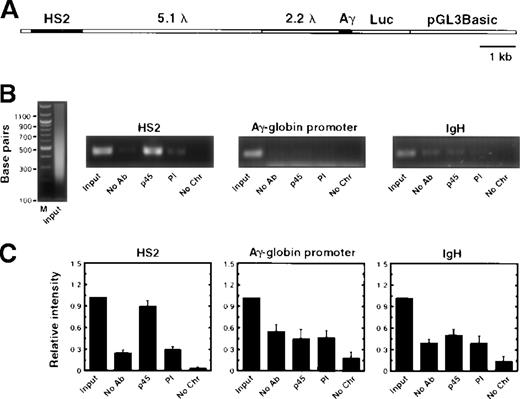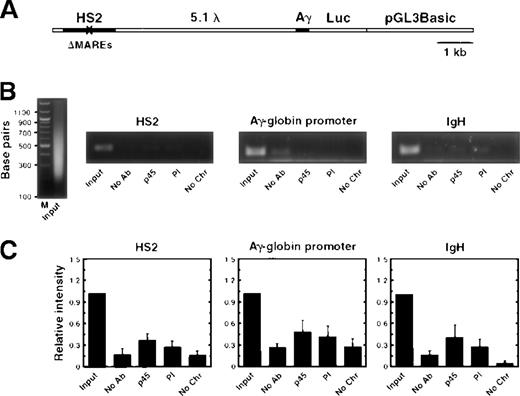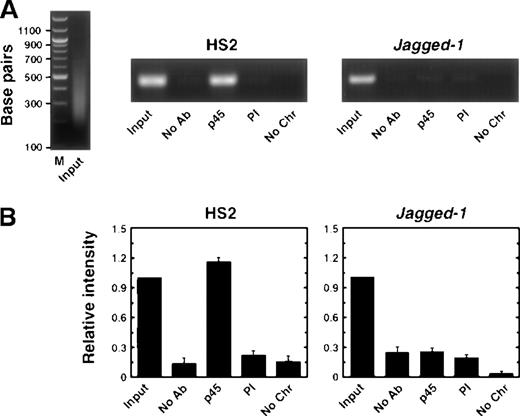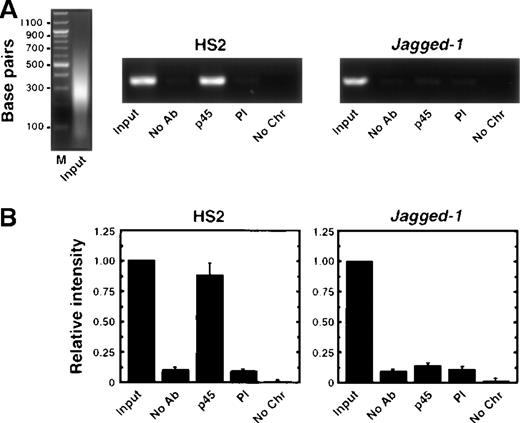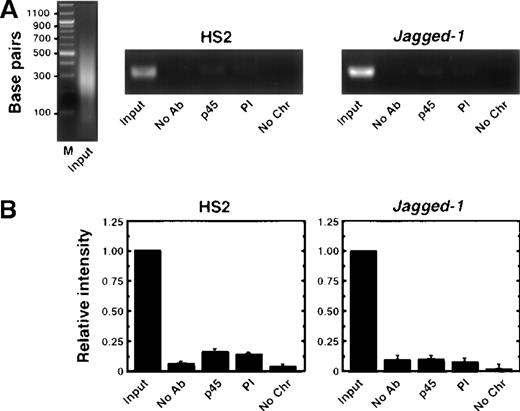Abstract
The human β-globin locus control region (LCR) confers high-level, tissue-specific expression to the β-globin genes. Tandem Maf recognition elements (MAREs) within the hypersensitive site 2 (HS2) subregion of the LCR are important for the strong enhancer activity of the LCR. Multiple proteins are capable of interacting with these sites in vitro, including the erythroid cell- and megakaryocyte-specific transcription factor, NF-E2. The importance of NF-E2 for β-globin gene expression is evident in murine erythroleukemia cells lacking the p45 subunit of NF-E2. These CB3 cells have a severe defect in - and β-globin gene transcription, which can be restored by expression of NF-E2. However, mice nullizygous for p45 express nearly normal levels of β-globin. Thus, either a redundant factor(s) exists in mice that can functionally replace NF-E2, or NF-E2 does not function through the LCR to regulate β-globin gene expression. To address this issue, we asked whether NF-E2 binds directly to the tandem MAREs of HS2 in intact cells. Using a chromatin immunoprecipitation assay, we provide evidence for NF-E2 binding directly and specifically to HS2 in living erythroleukemia cells and in mouse fetal liver. The specific immunoisolation of HS2 sequences was dependent on the presence of p45 and on intact MAREs within HS2. These results support a direct role for NF-E2 in the regulation of β-globin gene expression through activation of the LCR.
High-level, erythroid-specific expression of the β-globin genes depends on the upstream locus control region (LCR).1,2 The β-globin LCR consists of 4 erythroid-specific DNaseI hypersensitive sites (HS1-HS4)3that function together to confer position-independent and copy number–dependent expression to linked transgenes in mice.1,4 In addition, the LCR confers long-range transactivation in transient5 and stable transfection assays.6 The importance of the LCR for β-globin gene expression in vivo is evident from a naturally occurring deletion of the human LCR and additional upstream sequences, which results in severe β-thalassemia, even though the β-globin genes are intact.7 The critical role of the LCR in conferring high-level β-globin gene transcription has been confirmed by disruption of HS1-HS4 via homologous recombination in murine embryonic stem cells.8,9 In addition to its effects on β-globin gene transcription, the LCR is important for establishing the timing of DNA replication of the β-globin locus during the S phase of the cell cycle.7,10 11 Despite numerous studies on the role of the LCR in controlling β-globin gene expression, the mechanism of long-range transactivation by the LCR is poorly understood.
Central to the understanding of LCR function is the identification of the transcription factors mediating the enhancer activity of the LCR. A conserved sequence, TGCTGA(C/G)TCA(T/C), within HS2 is critical for strong enhancer activity.12-15 This Maf recognition element (MARE)16 is bound by multiple homodimeric and heterodimeric transcription factors in vitro. These factors include Maf homodimers, heterodimers containing a Maf subunit and another bZIP protein (NF-E2, Nrf1, Nrf2, Bach1, Bach2), and heterodimers lacking a Maf subunit (AP1).17-22 Several lines of evidence support a role for NF-E2 in the regulation of β-globin gene expression. First, expression of the p45 subunit of NF-E2 is restricted to certain hematopoietic cells, whereas other MARE binding proteins such as AP1, Nrf1, Nrf2, Bach1, and Bach2 are expressed more widely. Second, NF-E2 is the major protein in nuclear extracts from mouse erythroleukemia (MEL) cells that binds the tandem MAREs of HS2, and globin gene expression closely parallels the amount of NF-E2 binding activity.23 Third, the MEL cell line CB3, which lacks p45,24 is severely impaired in globin gene expression, and transcription can be rescued by expression of NF-E2.23 24
In contrast to studies supporting a role for NF-E2 in expression of the β-globin genes, mice lacking p45 have nearly normal levels of β-globin. Thus, either a redundant factor(s) functionally replaces NF-E2, or NF-E2 does not function through the LCR to regulate β-globin gene expression. To address this issue, we asked whether NF-E2 binds directly to the tandem MAREs of HS2 in intact cells. Using a chromatin immunoprecipitation (ChIP) assay involving the cross-linking of proteins to chromatin in living cells, followed by immunoprecipitation with an anti-p45 antibody, we show that NF-E2 binds directly and specifically to HS2. These results provide strong evidence for a direct role of NF-E2 in LCR function.
Material and methods
Cell culture
The human erythroleukemia cell line K56225 was propagated in Iscove's Modified Eagle's Medium (Biofluids, Rockville, MD), containing 25 mg/mL gentamycin and 10% fetal calf serum (Gibco-BRL, Grand Island, NY). MEL26 and CB324 cells were maintained in Dulbecco's Modified Eagle's Medium (DMEM) (Biofluids), containing 25 μg/mL gentamycin and 5% calf serum plus 5% fetal calf serum (MEL) or 10% fetal calf serum (CB3). Cell lines were grown in a humidified incubator at 37°C, in the presence of 5% carbon dioxide. Stably transfected clones of K562 cells were selected and maintained in the presence of 0.2 and 0.1 mg/mL hygromycin B (Sigma, St Louis, MO), respectively, as described previously.6,27 The following K562-derived clonal cell lines were used: HS2(7.3)γluciferase (32 copies; luciferase activity, 45.3 RLU/s/μg), HS2(2.2)γluciferase-20 (2 copies; luciferase activity, 289 000 RLU/s/ μg), HS2(2.2)γluciferase-11 (12 copies; luciferase activity, 526 000 RLU/ s/μg), HS2(Gal4)5.1γluciferase-10 (2 copies; luciferase activity, 135 RLU/s/μg), and HS2(Gal4)γluciferase-11 (8 copies; luciferase activity, 16 800 RLU/s/μg).5,6 28
Fetal livers and brains
Care and use of laboratory animals were in accordance with the University of Wisconsin Institutional Animal Care and Use Committee and the Guide for the Care and Use of Laboratory Animals (National Institutes of Health publication 85-23, revised 1985). F1 hybrids of the genetic background C57Bl/6 × CBA, purchased from the Jackson Laboratories, Bar Harbor, ME, maintained under pathogen-free light-reversed conditions (dark period: 13.00-1.00), were mated.29 Pregnant females were killed by cervical dislocation at approximately 14.5 to 14.75 days postcoitum (dpc); the uterine horns were placed in phosphate-buffered saline (PBS) (Sigma) and the uterine muscles were dissected away from the decidua. The F2 conceptuses were dissected out of the decidua in DMEM-based dissection medium30 and immediately decapitated. Livers were dissected within 30 minutes of dam death and the brain hemispheres within 45 minutes. Pooled livers and brains from each litter were passed separately through a 21-gauge syringe in 20 mL of DMEM-based medium,30 and cross-linking was performed immediately as described below.
Southern blot analysis
Southern blot analysis to determine copy number and integrity of stably integrated constructs was performed as described previously.6 The number of integrated copies was determined by PhosphorImager (Molecular Dynamics, Sunnyvale, CA) analysis, comparing the signal to a standard curve generated with known amounts of plasmid DNA.
Chromatin immunoprecipitation assay
The chromatin immunoprecipitation technique was adapted from Boyd and Farnham.31,32 Protein-DNA cross-linking was performed by incubating cells (2 × 107 per condition) or fetal liver or brain (approximately 2 livers or brains per condition) with formaldehyde at a final concentration of 0.4% for 10 minutes at room temperature with gentle agitation. Glycine (0.125 mol/L) was added to quench the reaction. Cells were then collected by centrifugation at × 240g for 8 minutes and washed in PBS. Nuclei were isolated by incubation in cell lysis buffer(10 mmol/L Tris,10 mmol/L NaCl, 0.2% Nonidet P-40, pH 8.0) for 10 minutes on ice, followed by centrifugation at × 600g for 5 minutes. Nuclei were lysed in nuclei lysis buffer (50 mmol/L Tris, 10 mmol/L EDTA, 1% SDS, pH 8.1) for 10 minutes on ice. The lysate was sonicated with 8 pulses of 30 seconds each at 50% to 60% of maximum power with a Heat Wave Systems W185F sonicator (Ultrasonics, Inc, Plainview, NY), equipped with a microtip to reduce the chromatin fragments to an average size of less than 500 base pairs (bp). Soluble chromatin was precleared by addition of 50 μL preimmune serum, followed by 100 μL Protein A-Sepharose. An aliquot of precleared chromatin was removed (input) and used in the subsequent polymerase chain reaction (PCR) analysis. The remainder of the chromatin was diluted with IP dilution buffer (20 mmol/L Tris, 150 mmol/L NaCl, 2 mmol/L EDTA, 0.01% SDS, 1% Triton X-100, pH 8.1) and incubated with or without 2% anti-p45 polyclonal serum33 or preimmune serum in a final volume of 800 μL for 3 hours at 4°C. Immune complexes were collected by incubation with 30 μL Protein A-Sepharose for 2 hours at 4°C. A control sample was prepared in all experiments in which IP wash buffer 1 (20 mmol/L Tris, 150 mmol/L NaCl, 2 mmol/L EDTA, 0.1% SDS, 1% Triton X-100, pH 8.1) was added instead of chromatin. Protein A-Sepharose pellets were washed twice with 500 μL aliquots of IP wash buffer 1, once with IP wash buffer 2 (10 mmol/L Tris, 0.25 mol/L LiCl, 1 mmol/L EDTA, 1% Nonidet P-40, 1% desoxycholate, pH 8.1), and twice with TE (10 mmol/L Tris, 1 mmol/L EDTA, pH 8.0). Immune complexes were eluted twice with 150 μL of IP elution buffer (0.1 mol/L NaHCO3, 1% SDS). RNaseA (0.03 mg/mL) and NaCl (0.3 mol/L) were added, and cross-links were reversed by incubation for 4 to 5 hours at 65°C. DNA was purified by ethanol precipitation using glycogen (5 μg) as a carrier. Pellets were resuspended in 100 μL TE and 25 μL PK buffer (50 mmol/L Tris, 25 mmol/L EDTA, 1.25% SDS, pH 7.5) and digested with Proteinase K (0.24 mg/mL) for 2 hours at 45°C. DNA was purified by 2 extractions with phenol:chloroform, followed by ethanol precipitation. Purified DNA was resuspended in 30 μL water. Aliquots of 2 μL were analyzed by PCR, with the appropriate primer pairs. PCR products were resolved on 1.6% agarose gels containing ethidium bromide and quantitated using NIH Image version 1.61.1 (National Institutes of Health, Bethesda, MD). Importantly, the signals were proportional to the amount of DNA input in PCRs.
Primers
The primer pair 5′-gacatgactcagcattgctgtgc-3′ and 5′-gaaaatagtgtttagcatccagcagg-3′ amplifies a 301-bp fragment of human HS2 (8371-8671). The latter primer used with 5′-acggaggagagtcttccgctcg-3′, which anneals to the Gal4 binding site, amplifies a 310-bp HS2 fragment of HS2(Gal4)5.1γluciferase. The primer pair 5′-aattaagcagcagtatcctcttggg-3′ and 5′-gttccagaagcgagtgtgtgg-3′ amplifies a 249-bp fragment of the human Aγ-globin promoter. The primer pair 5′-tctgcccagaatgagtcactcaagg-3′ and 5′-tttgagccttcgcgttctctgc-3′ amplifies a 249-bp fragment of the human immunoglobulin heavy chain (IgH) locus HS12 regulatory element.34 The primer pair 5′-ttcctacacattaacgagcctctgc-3′ and 5′-aacatctggccacacaccctaagc-3′ amplifies a 279-bp fragment of mouse HS2. The primer pair 5′-agtgcccagagcttgaaccg-3′ and 5′-ctaaggctgccatcaccattagg-3′ amplifies a 380-bp fragment of the mouse Jagged-1 gene. All primer pairs amplify a single band of the expected size.
Results
To determine whether NF-E2 interacts directly with HS2 of the endogenous β-globin LCR (Figure 1A), we used a ChIP assay. Living K562 cells were incubated with formaldehyde to cross-link proteins to chromatin. The chromatin was then sonicated to generate fragments averaging less than 500 bp (Figure 1B, left). Antibodies specific for the p45 subunit of NF-E2 were used to immunoprecipitate protein-DNA complexes. The immunoprecipitated DNA was analyzed by PCR with primers specific for HS2, the Aγ-globin promoter, and the HS12 enhancer element of the IgH locus. Representative ethidium bromide-stained agarose gels of the input chromatin and PCR products are shown in Figure 1B. Immunoprecipitation with the anti-p45 antibody resulted in the recovery of considerably more HS2 relative to the preimmune sera, no antibody, and no chromatin controls. In contrast, the Aγ-globin promoter and the HS12 enhancer element of the IgH locus, which both lack MAREs, were not enriched in the anti-p45 condition in the same experiment. The average enrichment of HS2 in the anti-p45 antibody versus the preimmune condition was 8.2 ± 2.4-fold (mean ± SEM, n = 5) (Figure 1C). The corresponding numbers for the Aγ-globin promoter and IgH were 1.4 ± 0.3-fold and 1.2 ± 0.1-fold, respectively (mean ± SEM, n = 4). These results provide strong evidence that NF-E2 associates with HS2 in intact cells, and the controls illustrate the specificity of the interaction.
NF-E2 interacts directly with endogenous HS2 in K562 cells.
(A) Diagram of the human β-globin locus. Circles and rectangles represent DNaseI hypersensitive sites and the β-globin genes (ε, embryonic; Gγ and Aγ, fetal; and β, adult), respectively. The tandem MAREs within HS2 are indicated. (B) Ethidium bromide-stained agarose gels of input chromatin (left panel) and PCR products using primers specific for HS2, the Aγ-globin promoter, and IgH from a representative experiment. The immunoprecipitation conditions are indicated below each lane. No antibody, No Ab; anti-p45 polyclonal sera, p45; preimmune sera, PI; no chromatin, No Chr. (C) Relative intensity of PCR products from 5 independent experiments (mean ± SEM). The signal obtained with 0.02% of input was set to 1.
NF-E2 interacts directly with endogenous HS2 in K562 cells.
(A) Diagram of the human β-globin locus. Circles and rectangles represent DNaseI hypersensitive sites and the β-globin genes (ε, embryonic; Gγ and Aγ, fetal; and β, adult), respectively. The tandem MAREs within HS2 are indicated. (B) Ethidium bromide-stained agarose gels of input chromatin (left panel) and PCR products using primers specific for HS2, the Aγ-globin promoter, and IgH from a representative experiment. The immunoprecipitation conditions are indicated below each lane. No antibody, No Ab; anti-p45 polyclonal sera, p45; preimmune sera, PI; no chromatin, No Chr. (C) Relative intensity of PCR products from 5 independent experiments (mean ± SEM). The signal obtained with 0.02% of input was set to 1.
To further assess the specificity of the NF-E2 interaction with HS2, we tested whether NF-E2 could be cross-linked to an HS2-containing integrated luciferase reporter construct. We performed ChIP assays using a clonal K562 cell line containing the HS2(7.3)γluciferase construct shown in Figure 2A. Figure 2B shows ethidium bromide-stained agarose gels of the input chromatin and PCR products. HS2 was specifically enriched by immunoprecipitation with the anti-p45 antibody versus preimmune control (3.2 ± 0.4-fold; mean ± SEM, n = 5), whereas there was no enrichment of the Aγ-globin promoter (1.0 ± 0.2-fold; mean ± SEM, n = 5) or IgH (1.3 ± 0.3-fold; mean ± SEM, n = 5). Analysis of 2 additional clones, HS2(2.2)γluciferase-20 and HS2(2.2)γluciferase-11, resulted in a specific 31- and 18-fold enrichment of HS2 with the anti-p45 antibody versus preimmune control, respectively, whereas no enrichment of IgH was observed (2 independent experiments). Thus, similar to the results with endogenous HS2, NF-E2 binds to HS2 of an integrated luciferase reporter construct.
NF-E2 interacts with HS2 of a stably integrated reporter construct.
(A) Structure of the HS2 (7.3)γluciferase reporter construct stably integrated into K562 cells. HS2 was separated from the Aγ-globin promoter by 2phage lambda MluI fragments (5.1 λ and 2.2 λ). (B) Ethidium bromide-stained agarose gels of input chromatin (left panel) and PCR products of samples using primers specific for HS2, the Aγ-globin promoter, and IgH from a representative experiment. The immunoprecipitation conditions are indicated below each lane. No antibody, No Ab; anti-p45 polyclonal sera, p45; preimmune sera, PI; no chromatin, No Chr. (C) Relative intensity of PCR products from at least 4 independent experiments (mean ± SEM). The signal obtained with 0.02% of input was set to 1.
NF-E2 interacts with HS2 of a stably integrated reporter construct.
(A) Structure of the HS2 (7.3)γluciferase reporter construct stably integrated into K562 cells. HS2 was separated from the Aγ-globin promoter by 2phage lambda MluI fragments (5.1 λ and 2.2 λ). (B) Ethidium bromide-stained agarose gels of input chromatin (left panel) and PCR products of samples using primers specific for HS2, the Aγ-globin promoter, and IgH from a representative experiment. The immunoprecipitation conditions are indicated below each lane. No antibody, No Ab; anti-p45 polyclonal sera, p45; preimmune sera, PI; no chromatin, No Chr. (C) Relative intensity of PCR products from at least 4 independent experiments (mean ± SEM). The signal obtained with 0.02% of input was set to 1.
To determine whether the tandem MAREs were required for the interaction of NF-E2 with HS2, K562 cells were stably transfected with the HS2(Gal4)5.1γluciferase reporter construct in which a single Gal4 binding site was substituted for the tandem MAREs while maintaining the correct spacing between adjacent cis-acting elements (Figure3A). Immunoprecipitation with the anti-p45 antibody did not enrich for the MARE-deficient mutant of HS2 (Figure3B,C). In contrast, formaldehyde cross-linked NF-E2 to endogenous HS2 in these cells (data not shown). Similar results were obtained with a second clonal cell line containing the integrated HS2(Gal4)γluciferase reporter construct (data not shown). The ratios of PCR products in the anti-p45 antibody versus preimmune conditions for HS2, the Aγ-globin promoter, and IgH were 1.4 ± 0.1-, 1.2 ± 0.1-, and 1.5 ± 0.2-fold, respectively (mean ± SEM, n = 3). These results show that the tandem MAREs are required for the interaction of NF-E2 with HS2 and therefore further validate the results showing cross-linking of NF-E2 to endogenous HS2.
The tandem MAREs of HS2 are necessary for the interaction of NF-E2 with HS2.
(A) Structure of the HS2(Gal4)5.1γluciferase reporter construct stably integrated into K562 cells. HS2 was separated from the Aγ-globin promoter by a 5.1 kilobase (kb) phage lambda MluI fragment (5.1 λ). (B) Ethidium bromide-stained agarose gels of input chromatin (left panel) and PCR products of samples using primers specific for the mutated HS2 lacking MAREs, the Aγ-globin promoter, and IgH from a representative experiment. The immunoprecipitation conditions are indicated below each lane. No antibody, No Ab; anti-p45 polyclonal sera, p45; preimmune sera, PI; no chromatin, No Chr. (C) Relative intensity of PCR products from at least 3 independent experiments (mean ± SEM). The signal obtained with 0.02% of input was set to 1.
The tandem MAREs of HS2 are necessary for the interaction of NF-E2 with HS2.
(A) Structure of the HS2(Gal4)5.1γluciferase reporter construct stably integrated into K562 cells. HS2 was separated from the Aγ-globin promoter by a 5.1 kilobase (kb) phage lambda MluI fragment (5.1 λ). (B) Ethidium bromide-stained agarose gels of input chromatin (left panel) and PCR products of samples using primers specific for the mutated HS2 lacking MAREs, the Aγ-globin promoter, and IgH from a representative experiment. The immunoprecipitation conditions are indicated below each lane. No antibody, No Ab; anti-p45 polyclonal sera, p45; preimmune sera, PI; no chromatin, No Chr. (C) Relative intensity of PCR products from at least 3 independent experiments (mean ± SEM). The signal obtained with 0.02% of input was set to 1.
MEL cells represent a later developmental stage than K562 cells, expressing mainly β-globin26 versus the predominantly γ-globin expression characteristic of K562 cells.25 Thus, it is possible that a factor(s) functioning through MAREs in MEL cells would be distinct from NF-E2. To determine whether NF-E2 interacts with HS2 in MEL cells, we used the same approach as described above. The Jagged-1 gene, which lacks MAREs,35 was used as a control. The anti-p45 antibody specifically immunoprecipitated HS2 (Figure 4). The ratios of PCR products in the p45 antibody versus preimmune conditions for HS2 and Jagged-1 were 7.7 ± 1.8- and 1.3 ± 0.1-fold, respectively (mean ± SEM, n = 8). Thus, similar to the K562 cells, NF-E2 interacts specifically with endogenous HS2 in living MEL cells.
NF-E2 interacts directly with endogenous HS2 in living MEL cells.
(A) Ethidium bromide-stained agarose gels of input chromatin (left panel) and PCR products of samples using primers specific for mouse HS2 and the Jagged-1 gene from a representative experiment. The immunoprecipitation conditions are indicated below each lane. No antibody, No Ab; anti-p45 polyclonal sera, p45; preimmune sera, PI; no chromatin, No Chr. (B) Relative intensity of PCR products from 4 independent experiments (mean ± SEM). The signal obtained with 0.06% of input was set to 1.
NF-E2 interacts directly with endogenous HS2 in living MEL cells.
(A) Ethidium bromide-stained agarose gels of input chromatin (left panel) and PCR products of samples using primers specific for mouse HS2 and the Jagged-1 gene from a representative experiment. The immunoprecipitation conditions are indicated below each lane. No antibody, No Ab; anti-p45 polyclonal sera, p45; preimmune sera, PI; no chromatin, No Chr. (B) Relative intensity of PCR products from 4 independent experiments (mean ± SEM). The signal obtained with 0.06% of input was set to 1.
CB3 cells were derived from MEL cells and lack p45 because of retroviral integration in one p45 allele and loss of the other allele.24 Thus, one would not expect to immunoprecipitate HS2 using the anti-p45 antibody with formaldehyde cross-linked chromatin from these cells. The results of Figure5 are consistent with this; there was no enrichment of HS2 using the anti-p45 antibody. The ratios of PCR products in the anti-p45 antibody versus preimmune conditions for HS2 and Jagged-1 were 1.5 ± 0.3- and 1.3 ± 0.2-fold, respectively (mean ± SEM, n = 8).
The anti-p45 antibody does not immunoprecipitate HS2 in CB3 cells.
(A) Ethidium bromide-stained agarose gels of input chromatin (left panel) and PCR products of samples using primers specific for mouse HS2 and the Jagged-1 gene from a representative experiment. The immunoprecipitation conditions are indicated below each lane. No antibody, No Ab; anti-p45 polyclonal sera, p45; preimmune sera, PI; no chromatin, No Chr. (B) Relative intensity of PCR products from 4 independent experiments (mean ± SEM). The signal obtained with 0.06% of input was set to 1.
The anti-p45 antibody does not immunoprecipitate HS2 in CB3 cells.
(A) Ethidium bromide-stained agarose gels of input chromatin (left panel) and PCR products of samples using primers specific for mouse HS2 and the Jagged-1 gene from a representative experiment. The immunoprecipitation conditions are indicated below each lane. No antibody, No Ab; anti-p45 polyclonal sera, p45; preimmune sera, PI; no chromatin, No Chr. (B) Relative intensity of PCR products from 4 independent experiments (mean ± SEM). The signal obtained with 0.06% of input was set to 1.
Because the p45 nullizygous cell line CB3 has severely impaired globin synthesis, but p45 nullizygous mice express nearly normal levels of globin, it is possible that the requirement of NF-E2 for globin gene transcription is unique to transformed cell lines. To test whether p45 interacts directly with HS2 in mice, we performed ChIP assays in tissue preparations from 14.5 dpc mouse embryos. Figures6 and 7 show the specific enrichment of HS2 upon immunoprecipitations of fetal liver chromatin with the anti-p45 antibody. In contrast, no enrichment of HS2 was seen with fetal brain. The ratios of PCR products in the anti-p45 antibody versus preimmune conditions for HS2 andJagged-1 in liver were 8.6 ± 1.2- and 1.3 ± 0.1-fold, respectively (mean ± SEM, n = 2), and in brain 1.1 ± 0.1- and 1.2 ± 0.04-fold, respectively (mean ± SEM, n = 2).
NF-E2 interacts directly with endogenous HS2 in mouse fetal liver.
(A) Ethidium bromide-stained agarose gels of input chromatin (left panel) and PCR products of samples using primers specific for mouse HS2 and the Jagged-1 gene from a representative experiment. The immunoprecipitation conditions are indicated below each lane. No antibody, No Ab; anti-p45 polyclonal sera, p45; preimmune sera, PI; no chromatin, No Chr. (B) Relative intensity of PCR products from 2 independent experiments (mean ± SEM). The signal obtained with 0.06% of input was set to 1.
NF-E2 interacts directly with endogenous HS2 in mouse fetal liver.
(A) Ethidium bromide-stained agarose gels of input chromatin (left panel) and PCR products of samples using primers specific for mouse HS2 and the Jagged-1 gene from a representative experiment. The immunoprecipitation conditions are indicated below each lane. No antibody, No Ab; anti-p45 polyclonal sera, p45; preimmune sera, PI; no chromatin, No Chr. (B) Relative intensity of PCR products from 2 independent experiments (mean ± SEM). The signal obtained with 0.06% of input was set to 1.
The anti-p45 antibody does not immunoprecipitate HS2 in mouse fetal brain.
(A) Ethidium bromide-stained agarose gels of input chromatin (left panel) and PCR products of samples using primers specific for mouse HS2 and the Jagged-1 gene from a representative experiment. The immunoprecipitation conditions are indicated below each lane. No antibody, No Ab; anti-p45 polyclonal sera, p45; preimmune sera, PI; no chromatin, No Chr. (B) Relative intensity of PCR products from 2 independent experiments (mean ± SEM). The signal obtained with 0.06% of input was set to 1.
The anti-p45 antibody does not immunoprecipitate HS2 in mouse fetal brain.
(A) Ethidium bromide-stained agarose gels of input chromatin (left panel) and PCR products of samples using primers specific for mouse HS2 and the Jagged-1 gene from a representative experiment. The immunoprecipitation conditions are indicated below each lane. No antibody, No Ab; anti-p45 polyclonal sera, p45; preimmune sera, PI; no chromatin, No Chr. (B) Relative intensity of PCR products from 2 independent experiments (mean ± SEM). The signal obtained with 0.06% of input was set to 1.
Discussion
In summary, we have shown that NF-E2 can be cross-linked to HS2 in living erythroleukemia cells and in mouse fetal liver, and that the interaction required tandem MAREs and p45. During the preparation of this article, Daftari et al36 also described the cross-linking of NF-E2 to HS2 in K562 cells. Taken together, these studies provide strong evidence for a direct involvement of NF-E2 in β-globin gene regulation through LCR activation. These results do not rule out the possibility that other component(s) interact with the MAREs under certain conditions.
On the basis of these results, it is reasonable to hypothesize that the lack of a severe globin deficiency in p45 nullizygous mice is due to functional redundancy between NF-E2 and one or more additional factors. Our results are inconsistent with a model in which NF-E2 is not a major transactivator functioning through the tandem MAREs, at least in human and mouse erythroleukemia cells. The relatively normal globin expression in compound p45/Nrf2 knock-out mice37 strongly argues against Nrf2 being the redundant factor. The role of Nrf1 in globin synthesis in the absence of NF-E2 will be hard to evaluate in vivo because of the embryonic lethal phenotype of Nrf1 nullizygous mice.38 Other possible candidates include the recently identified Bach1 and Bach2 proteins. The ubiquitously expressed Bach1 can activate transcription through MAREs in transient transfection assays in erythroid cells,22 but its role in erythropoiesis is unknown. Bach2 is a less likely candidate because its expression is restricted to monocytes and neuronal cells, and it was shown to repress transcription upon ectopic expression in erythroid cells.22One would assume that the redundant factor would compensate for the lack of p45 in CB3 cells. However, because this transformed cell line lacks other factors in addition to p45, including p5339 and the heterogeneous nuclear RNA-binding protein A1,40 it is possible that the redundant factor is also missing in this system. An alternative explanation to factor redundancy invokes compensatory mechanisms rendering the globin promoters less dependent on the LCR. Such a compensatory mechanism may involve up-regulation of limiting factors, which normally require the LCR for recruitment to the promoter. This may also explain the results of the deletion of murine HS2, which only modestly reduces globin gene expression.41
On the basis of the importance of NF-E2 for globin synthesis in CB3 cells and megakaryopoiesis in mice, it is of considerable interest to determine how NF-E2 activates transcription. Strong transactivation mediated by NF-E2 requires the coactivator CBP/p300.5,42CBP/p300 is critical for LCR-mediated transactivation, and the tandem MAREs are necessary for recruiting CBP/p300 to the LCR.5 In addition to CBP/p300, a proline rich WW domain ligand binding motif within the transactivation domain of p45 is required for optimal β-globin expression, implicating a WW domain protein in transactivation mediated by NF-E2.33 As it is now clear that NF-E2 interacts directly with the LCR, one can ask what role the NF-E2 interacting factors have in the synergism between the individual HSs of the LCR, which confers high-level, long-range transactivation to the β-globin genes.
Acknowledgments
We thank members of Dr Peggy Farnham's laboratory for helpful discussions on chromatin immunoprecipitation assays.
Supported by National Institutes of Health Grant No. DK50107 (E.H.B.) and R29 HD36847-02 (K.M.D). This work was done during the tenure of a fellowship from the American Heart Association, Northland Affiliate, Inc (E.C.F.) and a Scholar Award from the Leukemia Society of America (E.H.B.).
Reprints:Emery H. Bresnick, University of Wisconsin Medical School, Department of Pharmacology, 387 Medical Sciences Center, 1300 University Ave, Madison, WI 53706; e-mail: ehbresni@facstaff.wisc.edu.
The publication costs of this article were defrayed in part by page charge payment. Therefore, and solely to indicate this fact, this article is hereby marked “advertisement” in accordance with 18 U.S.C. section 1734.


